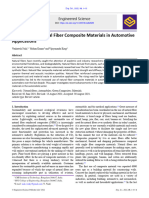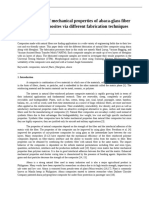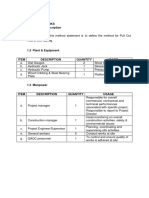Experimental Investigation of Jute Fiberreinforcednano Clay Composite
Experimental Investigation of Jute Fiberreinforcednano Clay Composite
Uploaded by
dennisitty01Copyright:
Available Formats
Experimental Investigation of Jute Fiberreinforcednano Clay Composite
Experimental Investigation of Jute Fiberreinforcednano Clay Composite
Uploaded by
dennisitty01Original Title
Copyright
Available Formats
Share this document
Did you find this document useful?
Is this content inappropriate?
Copyright:
Available Formats
Experimental Investigation of Jute Fiberreinforcednano Clay Composite
Experimental Investigation of Jute Fiberreinforcednano Clay Composite
Uploaded by
dennisitty01Copyright:
Available Formats
Available online at www.sciencedirect.
com
ScienceDirect
Procedia Materials Science 10 (2015) 238 242
2nd International Conference on Nanomaterials and Technologies (CNT 2014)
Experimental Investigation of Jute FiberReinforcedNano Clay
Composite
K Deepaka,*, S V Prabhakar Vattikutia, B Venkatesh
a
Department of Mechanical Engineering, Vardhaman College of Engineering,Hyderabad, Telangana, 501218, India
Abstract
The effect of addition of nano clay and water absorption on jute fibreshas been studied. Although glass and other synthetic fibrereinforced plastics possess high specific strength, their fields of application are very limited because of the inherent higher cost of
production. To overcome this limitation, an investigation has been carried out to make use of jute, a natural fibre which is
abundantly available at lower cost. In the present work, a new composite is developed in which jutefibresare reinforced with
polyester resin and with the addition of nano clay.Themechanical properties of the new composite are evaluated. The wide
variety of bio composite processing techniques as well as the factors such as moisture content, fibre type and content, and their
influence on composites properties are discussed. The addition of nano clay to the jutefibre reinforced composites exhibited
significant improvement in the mechanical propertiesat lower cost and therefore can be used as a substitute to glass and synthetic
fibres.
2015 The Authors. Published by Elsevier Ltd. This is an open access article under the CC BY-NC-ND license
2015 The Authors. Published by Elsevier Ltd.
(http://creativecommons.org/licenses/by-nc-nd/4.0/).
Peer-review under responsibility of the International Conference on Nanomaterials and Technologies (CNT 2014).
Peer-review under responsibility of the International Conference on Nanomaterials and Technologies (CNT 2014)
Keywords:Nano clay; Biocomposite; Jute fibers, Composites properties.
1. Introduction
A composite material generally consists of relatively strong fibers in a tough resin matrix. Wood and bone are the
examples of natural composite materials. Cellulose fibers are found in wood in lignin matrix while bone contains
hydroxyapatite particles in a collagen matrix.Composite material has the main advantageof formability into more
* Corresponding author. Tel.: +91-939-403-3675
E-mail address: deepak045@live.com
2211-8128 2015 The Authors. Published by Elsevier Ltd. This is an open access article under the CC BY-NC-ND license
(http://creativecommons.org/licenses/by-nc-nd/4.0/).
Peer-review under responsibility of the International Conference on Nanomaterials and Technologies (CNT 2014)
doi:10.1016/j.mspro.2015.06.046
K. Deepak et al. / Procedia Materials Science 10 (2015) 238 242
complex shapes then their metallic counterparts. Use of composite material reducesthe number of parts making up a
given componentand also reduces the need for fasteners and joints which may otherwise weakenthe
component.There is a significant growth in the use of bio composites in the automotive and decking markets over
the past one decade. Sustainability, green chemistry and industrial ecology are driving the automotive industry to
seek alternative, Eco-friendly materials for automotive applications.Materials from renewable sources are sought to
replace not only the reinforcement element but also the matrix plane of composite materials, to overcome the
sustainability issues associated with using synthetic materials in composites. The use of natural fibers with polymers
based on renewable resources resolve many environmental related issues.The natural fibers such as flax, jute, hemp
and sisal have received considerable attention as an environmentally friendly alternative for the use of glass and
synthetic fibers in composites materials.The amount of energy needed and also the cost of production will be lesser
than that of glass fibers.
Taking the advantages offered by the renewable resources Garkhail, S. K. et al. (2001), have developed two types
of biodegradable composite materials using flax fibers as a reinforcement and poly R-3-hydroxyalkanoates as a
biodegradable polymer matrix. In the first one, natural-fiber-mat-reinforced thermoplastics were produced by
compression molding method and needle-punched nonwoven flax fiber mats and in the second one injection
molding compounds based on short flax fibers. The influence of processing method and fiber content on the tensile
and impact properties of these composites was studied. Results indicated that the addition of flax fiber to poly 3hydroxybutyrate could be advantageous as far as cost-performance of the material is concerned.
Sarah Christian et al. (2009)have made a study of the mechanical properties of biocomposites.Renewable
resources that biodegrade in an anaerobic environment were used to produce a biopolymer for a new generation of
composites. These biocomposites can be used as a fuel or feedstock after their useful service life.The biocomposite
materials so produced are being developed to replace less eco-friendly structural and non-structural materials used in
the construction.Hemp fabric was chosen as the natural fiber for biocompositesas it has high modulus of elasticity
relative to most other woven natural fibres such as flax and jute. The Hemp fabric was produced from cotton or
wood pulp, and Polyhydroxybuterate which is produced by microbes, were chosen as a matrix materials based on
preliminary studies. The tensile specimens were prepared and tested according to ASTM D638, Standard Test
Method for Tensile properties of Plastics Modulus of elasticity, maximum strength; percentage elongation and
Poissons ratio for the material were measured and calculated. It has been found that mechanical testing of
Hemp/Cellulose Acetate and Hemp/Polyhydroxybuterate composites have strength properties comparable to
structural lumber and higher than plywood. The moduli of elasticity of thebiocomposites are lower than that for
lumber and plywood parallel to grain. The deflection limits are expected to control the design of hemp biocomposite
components due to low modulus of elasticity.
RosanaMoriana et al. (1999) validated that the addition of cotton fibers to a starch-basedcommercial composite
material maintains its thermal stability and assures its biodegradation. Novel biocomposites based on a
biodegradable matrix reinforced with natural fibers have been developed in order to improve properties and reduce
costs. The influence of reinforcing a thermoplastic starch based matrix (Mater-Bi KE03B1R) with cotton fibers on
the composites biodegradability has been assessed. The biocompositeswere subjected to standardized accelerated
degradation in soil test (DIN 53739) for 535 days to mimic the post-disposal environmental conditions.Cotton fibers
were incorporated into pure thermoplastic starch based matrix, to assure the degradation of the synthetic component.
The surface produced by the degradation of cotton promotes attack by microorganisms and as a consequence, the
crystalline structure and the superficial morphology of the reinforced biocompositeswere more damaged by the soil
burial test than the pure Mater-Bi KE. The exceptional strength and stiffness to density ratios and superior physical
properties attracted the aviation and aerospace applications. The brief description about the use of composites in
aerospace applications was presented by Adam Quiter (2004).
The use of composite materials in commercial transport aircraft reduces airframe weight and enables better fuel
economy at lower operating costs.LawrenceT.Drzal, A. K. Mohanty et al. (2000) have reported the use of bio
composite materials as an alternative to petroleum based composite material for automotive application.Marc A.
Meyers, Albert V.M. LIN. et al. (2006) reports the overall design principles in biologicalstructural composites and
illustrates them for five examples: sea spicules, the abalone shell, the conch shell, the toucan and hornbill beaks, and
the sheep crab exoskeleton.Biological organisms produce composites that are organized in terms of composition and
structure containing both inorganic and organic components in complex structures. Structural biological materials
239
240
K. Deepak et al. / Procedia Materials Science 10 (2015) 238 242
exist as mineral and organic components.The mineral component provides the strength while the organic component
contributes to the ductility.The properties, technology, environmental credentials and market forces of the bio
composites were reported by Paul A Fowler et al. (2006). It presents a significant non-food market for cropderived fibers and resins. The various factors such as fiber architecture, the fiber-matrix interfacethat are influencing
the performance of bio composites were reported. It was specified that the fiber architecture which encompasses
fiber geometry fiber orientation, packing arrangement and fiber volume fraction controls many composite
properties, particularly mechanical properties. Among the properties, the fiber volume fraction is probably the single
proportional to the
mechanical properties. The interface
most important factor which is directly
between fiber and matrix is also crucial in terms of composite performance. The interface serves to transfer
externally applied loads to the reinforcement via shear stresses over the interface. Kurahatti et al. investigated the
matrix properties by introducing nano size ZrO2 fillers into an epoxy resin and reported increased flexural modulus
and flexural strength of epoxy. In the present work an attempt is made to enhance the properties of the natural fiber
reinforced polyester resin composite by adding the nano clay to the matrix.
2. Methodology
The jute and coir fibers have been taken and the laminates have been prepared by compression molding process.
Before the fabrication process the fibers are dipped in Sodium Hydroxide (NaOH) solution. The fibers are washed
thoroughly, dried and then were dipped in Sodium Hydroxide solution for one hour, then the fibers are taken washed
thoroughly again and then the fibers were dried at 50 0C. Then these fibers are taken for fabrication of laminates. For
the fabrication process General Polyester resin was used along with Accelerator (Cobalt Napthanate) and catalyst
MEKP (Methyl Ethyl Ketone Peroxide). Here both the accelerator and the catalyst act as the hardener. Garamite is
the nano clay used in this process. An optimum percentage of nano clay (say 3%) was taken and then mixed with the
GP resin in a mechanical stirrer for 3 hours and then it was kept in a vacuum oven to remove the voids present in it.
The laminates were prepared using compression molding technique. The jute fiber was taken and it was cut into
300mm x 300mm dimension. The fiber to resin ratio for natural fiber is 1:3. Two layers of jute fiber each weighing
105g were taken and the laminate was prepared with 630g of GP resin. The accelerator and catalyst were taken at
1.5 weight % of the total resin weight. Similarly the jute fiber laminates with the addition of clay and without clay
was prepared.
Fig. 1.Images of specimen preparation and testing.
3. Experimental Analysis
Tensile Test:
The tensile specimens are prepared according to the standard ASTM D3039. The specimen has a cross section of
300mm x 25mm x 3mm. The tensile test was carried out on the Universal Testing Machine which has a capacity of
400 kN. A constant gauge length of 150mm was maintained throughout the experiment. This test gives us the tensile
strength of each specimen. Table 2 shows the peak load and the tensile strength obtained during the tensile test.
241
K. Deepak et al. / Procedia Materials Science 10 (2015) 238 242
Table1. Tensile strength values of jute composite with nano clay.
Specimen code
Width
Thickness
Peak load
Tensile strength
(kN/mm2)
(mm)
(mm)
(kN)
26.18
3.34
3.2
0.037
25.26
3.31
3.5
0.042
25.89
3.35
3.64
0.043
Table 2: Tensile strength values for jute fiber without nano clay
Specimen
code
Width
Thickness
Peak load
Tensile strength
(kN/mm2)
(mm)
(mm)
(kN)
25.74
3.09
2.060
0.026
25.25
3.03
2.700
0.035
25.60
3.02
2.56
0.033
3.1. Impact Test:
The impact specimens are prepared according to the standard ASTM D 4812. The specimen has a cross section of
65mm x 12mm x 3mm. The impact test was carried out on the Izod Impact Testing Machine which has a capacity of
25 Joules. This test gives us the amount of energy absorbed by each specimen. Table 3 and 4 shows the results
obtained during the impact test. The energy absorbed values for jute reinforced composites with nano clay were
found to be higher than without nano clay.
Table 3: Energy absorption values for jute without nano clay
Specimen
code
Width
Thickness
Energy absorbed
(mm)
(mm)
(J)
13.89
2.94
0.6
13.42
3.02
0.5
13.20
2.95
0.6
Table 4: Energy absorption values for jute with nano clay
Specimen
code
Width
Thickness
Energy absorbed
(mm)
(mm)
(J)
13.28
3.56
0.6
13.13
3.54
0.7
13.14
3.39
0.7
Table 5: Compressive strength values for jute without nano clay
Specimen
code
Breaking Load
(kN)
Compressive strength
(kN/mm2)
17.820
0.105
16.060
0.095
16.620
0.098
242
K. Deepak et al. / Procedia Materials Science 10 (2015) 238 242
3.2. Compression Test:
The compression specimens are prepared according to the standard ASTM D 695.The specimen has a cross
section of 13mm x 13mm x 3mm. The compression test was carried out on the Universal Testing Machine which
has a capacity of 400 KN. This test gives us the compressive strength of each specimen. The following results were
obtained:
Table 6: Compressive strength values for jute without nano clay
Specimen
code
Breaking Load
(kN)
Compressive strength
(kN/mm2)
17.820
0.105
16.060
0.095
16.620
0.098
Conclusion:
The comparison between the mechanical properties of specimens with and without addition of nano clayhas been
studied. There is an increase in the tensile strength of the specimens that has the addition of clay in it. Impact energy
and the compressive strength of the jute fibers were also found to be increasing with the addition of clay. The clay
adds some reinforcement to the fibers. The mechanical properties determined from the tensile, impact and
compressive tests exhibit a similar behavior for each of the specimens with the addition of clay. Corresponding to
the mechanical properties, the storage modulus increased with the increase in the fiber loading in the composites due
to the reinforcement imparted by the fibers that allowed greater stress transfer at the interface. It has been clearly
seen that adding nanoclay had increased the viscosity of the resin mix. It has been suggested that the increased clayresin interactions leads to this. It is concluded that although the mechanical properties of jute/polyester composites
do not possess strengths and moduli as high as those of conventional composites,they do have better strengths than
wood composites and some plastics. Therefore, these composites could be considered for future materials use. Since
the reinforcing material is eco-friendly, non-toxic, non-health hazardous, low in cost and easily available as
compared to conventional fibers like glass, Kevlar, asbestos etc., the composites are a good substitute for wood in
indoor applications such as shelves, partitions, wash basins and table tops, and may also be suitable for outdoor uses
such as roofing, drainage pipes, automobile components, electrical fittings as well as larger items such as
lightweight fishing boats. To ascertain their suitability for outdoor applications, a few more tests are to be carried
out to evolve the hygro-thermal and weather resistance properties of these composites.
References
Adam Quiter, 2004, Composites in Aerospace Applications.
Lawrence T. Drzal, A. K. Mohanty, M. Misra, 2000, Bio-composite materials as alternatives to Petroleum-based
composites for automotive applications.Composite Materials and Structures Center, Michigan State University,
East Lansing, MI 48824
Garkhail, S. K.1, Meurs, E.1, Van de Beld, T.1 and Peijs T.2001, Thermoplastic composites based on
Biopolymers and natural fibers, Dutch Polymer Institute, Department of Mechanical Engineering,Eindhoven
University of Technology, PO Box 513 Sarah Christian et al., 2009, Sustainable Biocomposites for
Construction.RosanaMoriana and AmparoRibes-Greus, 1999, Reinforced biocomposites with guaranteed
degradability in soil, University Polytechnic of Valencia (UPV), Valencia, Spai
Kurahatti,. V. R A.O.Surendranathan, A V Ramesh Kumar, C.S. Wadageri, V Auradi and S A Kori, 2014, Dry
Sliding Wear Behaviour of Epoxyreinforced with nano ZrO 2 Particles, Procedia Materials Science 5 (2014) 274280.
Marc A. Meyers, Albert V.M. LIN, (2006), Structural BiologicalComposites:
Paul A Fowler, J Mark Hughes and Robert M Elias, 2006, Biocomposites: technology, environmental credentials
and market forces, Journal of the Science of Food and Agriculture, 86:17811789
You might also like
- Automatic Creation of Business Partner in FSCMDocument16 pagesAutomatic Creation of Business Partner in FSCMHarish Aginati100% (3)
- Review of Natural Fiber CompositesDocument10 pagesReview of Natural Fiber CompositesArvind RNo ratings yet
- Materials Today: Proceedings: Jonathan B. Dawit, Hirpa G. Lemu, Yohannes Regassa, Adugna D. AkessaDocument6 pagesMaterials Today: Proceedings: Jonathan B. Dawit, Hirpa G. Lemu, Yohannes Regassa, Adugna D. AkessaHelmi ChaâbeneNo ratings yet
- Synthesis, Characterization and Finite Element Analysis of Polypropylene Composite Reinforced by Jute and Carbon Fiber - 2023Document8 pagesSynthesis, Characterization and Finite Element Analysis of Polypropylene Composite Reinforced by Jute and Carbon Fiber - 2023bakhrul ilmiNo ratings yet
- PCX - Report - Doc 6Document15 pagesPCX - Report - Doc 6KANAPARTHY SRI RAGHURAMNo ratings yet
- Comparing Impact Behavior of Natural Fiber With Termite Mound and Egg Shell Filler Added Reinforced CompositeDocument8 pagesComparing Impact Behavior of Natural Fiber With Termite Mound and Egg Shell Filler Added Reinforced CompositeTJPRC PublicationsNo ratings yet
- Materials 13 02595 v2Document18 pagesMaterials 13 02595 v2Kalpesh IndiannNo ratings yet
- Aces 2018091914571891Document10 pagesAces 2018091914571891anunciano GuterresNo ratings yet
- Literature SurveyDocument14 pagesLiterature SurveyMukesh PatilNo ratings yet
- Fabrication of Natural Composite Fiber and Study of Its Properties Shubham Sharma, Ashish Srivastava, Abhishek KumarDocument12 pagesFabrication of Natural Composite Fiber and Study of Its Properties Shubham Sharma, Ashish Srivastava, Abhishek KumarPrince Ghosh EponNo ratings yet
- Development of A Hybrid - Untitled BorrachaDocument7 pagesDevelopment of A Hybrid - Untitled BorrachaPV Minox-ClubNo ratings yet
- Mechanical Properties of Natural Cellulose Fibers Reinforced PolymerDocument8 pagesMechanical Properties of Natural Cellulose Fibers Reinforced Polymernurshiyama89No ratings yet
- ProjectDocument23 pagesProjectRaghul KrishnaNo ratings yet
- Prasad 2018 IOP Conf. Ser. Mater. Sci. Eng. 402 012103 PDFDocument7 pagesPrasad 2018 IOP Conf. Ser. Mater. Sci. Eng. 402 012103 PDFlekNo ratings yet
- A Review On Mechanical Property of Sisal Glass Fiber - 2017 - Materials TodayDocument11 pagesA Review On Mechanical Property of Sisal Glass Fiber - 2017 - Materials TodayClaudia UngureanuNo ratings yet
- Review 1Document14 pagesReview 1karthikkolli420No ratings yet
- Article EffectOfGrainSizeOnTheStructurDocument9 pagesArticle EffectOfGrainSizeOnTheStructurSayan RakshitNo ratings yet
- Muthalagu 2021Document9 pagesMuthalagu 2021Mechanical Engg. Alagappa Poly College,KaraikudiNo ratings yet
- Composite Material ReportDocument22 pagesComposite Material ReportDevesh RajputNo ratings yet
- Box BehnkenDocument8 pagesBox BehnkenJHON ALEX LOPINTA CCANSAYANo ratings yet
- EM Assignment - PDF 1Document13 pagesEM Assignment - PDF 1zohaibNo ratings yet
- Mams MS Id 000149Document9 pagesMams MS Id 000149mahesh.kushwah22No ratings yet
- 1,2,5 12Document27 pages1,2,5 12ThiagarajanNo ratings yet
- Fig 1: Fiber Reinforced Polymer CompositesDocument23 pagesFig 1: Fiber Reinforced Polymer CompositesanonymousNo ratings yet
- 2.1 Overview On The Natural Fiber CompositesDocument11 pages2.1 Overview On The Natural Fiber Compositessubrat38No ratings yet
- ChaptersDocument123 pagesChaptersMuhammad Mostafizur RahmanNo ratings yet
- Mechanical and Thermal Characterization of Coir/ Hemp/polyester Hybrid Composite For Lightweight ApplicationsDocument12 pagesMechanical and Thermal Characterization of Coir/ Hemp/polyester Hybrid Composite For Lightweight Applicationsgp rajeshNo ratings yet
- Effect of Water Absorption On Mech Props of Hybrid Interwoven Cellulosic Fibre Reinforced Epoxy CompositesDocument32 pagesEffect of Water Absorption On Mech Props of Hybrid Interwoven Cellulosic Fibre Reinforced Epoxy Compositessanchana velalaganNo ratings yet
- Mechanical Properties of Geopolymer Composites Reinforced With Natural FibersDocument6 pagesMechanical Properties of Geopolymer Composites Reinforced With Natural FibersexowilzNo ratings yet
- Paper 7Document13 pagesPaper 7RakeshconclaveNo ratings yet
- Analysing The Combination and Positioning of Bio Fibre and Bio FibreDocument6 pagesAnalysing The Combination and Positioning of Bio Fibre and Bio FibreAadarsh SharmaNo ratings yet
- A Review On Natural Fibres in The ConcreteDocument5 pagesA Review On Natural Fibres in The Concreteasemamaw damtieNo ratings yet
- Development and Characterization of Sisal Fiber and Wood Dust Reinforced Polymeric CompositesDocument11 pagesDevelopment and Characterization of Sisal Fiber and Wood Dust Reinforced Polymeric CompositesGosa GutaNo ratings yet
- 1 s2.0 S2666682024000161 MainDocument12 pages1 s2.0 S2666682024000161 MainzicoNo ratings yet
- Ingris Panjang Serat GoniDocument6 pagesIngris Panjang Serat GoniWardahNo ratings yet
- Mechanical Characterisation of Rattan Fibre Polyester CompositeDocument9 pagesMechanical Characterisation of Rattan Fibre Polyester Compositesabenid984No ratings yet
- Mukherjee 2011Document12 pagesMukherjee 2011Johnny 17No ratings yet
- Experimental Investigations On Mechanical Properties of Jute Fiber Reinforced Composites With Polyester and Epoxy Resin MatricesDocument12 pagesExperimental Investigations On Mechanical Properties of Jute Fiber Reinforced Composites With Polyester and Epoxy Resin MatricesSayan RakshitNo ratings yet
- Hari Ij9Document14 pagesHari Ij9T Hari PrasadNo ratings yet
- Free Vibration Characteristics of Banana Sisal Natural Fibers Reinforced Hybrid Polymer Composite BeamDocument5 pagesFree Vibration Characteristics of Banana Sisal Natural Fibers Reinforced Hybrid Polymer Composite BeamDr Engr Md Zillur RahmanNo ratings yet
- Analysis of Mechanical and Wettability PropertiesDocument15 pagesAnalysis of Mechanical and Wettability PropertiesKasia FrątczakNo ratings yet
- Development and Testing of Natural FiberDocument6 pagesDevelopment and Testing of Natural Fiberarinzepaul841No ratings yet
- Comparative Study of Natural Fiber Reinforced ConcreteDocument5 pagesComparative Study of Natural Fiber Reinforced Concretesbaia amineNo ratings yet
- R BhoopatiDocument10 pagesR BhoopatiAnkit JaglanNo ratings yet
- A Review On Natural Fibres in The ConcreteDocument5 pagesA Review On Natural Fibres in The ConcreteHarshitha H DNo ratings yet
- Lobo 2021Document8 pagesLobo 2021Yerco muñozNo ratings yet
- Sisal 1Document10 pagesSisal 1gizaw chekoleNo ratings yet
- Processing and Characterization of Natural Fiber-Lycra Composite Reinforced With Epoxy ResinDocument5 pagesProcessing and Characterization of Natural Fiber-Lycra Composite Reinforced With Epoxy ResinsivaNo ratings yet
- Composites Based On Natural Fibre Fabrics: August 2010Document27 pagesComposites Based On Natural Fibre Fabrics: August 2010Sudhir Chakravarthy KatragaddaNo ratings yet
- Ijmet 08 01 001 PDFDocument14 pagesIjmet 08 01 001 PDFIAEME PublicationNo ratings yet
- Kenaf FibreDocument10 pagesKenaf FibreIfkar AzmiNo ratings yet
- Materials Today: Proceedings: Chethan Kumar G, Sagar M. Baligidad, A.C. Maharudresh, Nishchay Dayanand, T.N. ChetanDocument6 pagesMaterials Today: Proceedings: Chethan Kumar G, Sagar M. Baligidad, A.C. Maharudresh, Nishchay Dayanand, T.N. ChetanNISHCHAY DAYANANDNo ratings yet
- A Study On Mechanical Properties of Bamboo Fiber Rei - 2020 - Materials Today PDocument7 pagesA Study On Mechanical Properties of Bamboo Fiber Rei - 2020 - Materials Today PClaudia UngureanuNo ratings yet
- 10.1515 - Secm 2013 0130Document7 pages10.1515 - Secm 2013 0130Prince P. Bongabong IINo ratings yet
- Flexural Behaviors of Sandwich Composites Produced Using Recycled and Natural MaterialDocument10 pagesFlexural Behaviors of Sandwich Composites Produced Using Recycled and Natural MaterialyigitilgazNo ratings yet
- A Study On Mechanical Properties of Bamboo Fiber RDocument8 pagesA Study On Mechanical Properties of Bamboo Fiber RRachapalli AnjaliNo ratings yet
- Compo LabDocument8 pagesCompo LabBrandt GadorNo ratings yet
- Characterization Study of Jute and Glass Fiber Reinforced Hybrid Composite Material IJERTV2IS4188Document10 pagesCharacterization Study of Jute and Glass Fiber Reinforced Hybrid Composite Material IJERTV2IS4188Brhane TeklayNo ratings yet
- Investigating The Influence of Water Absorption and Mechanical Properties of Composites Reinforced With Banana and Roselle FibersDocument9 pagesInvestigating The Influence of Water Absorption and Mechanical Properties of Composites Reinforced With Banana and Roselle FibersIJRASETPublicationsNo ratings yet
- Investigationon The Mechanical and Morphological Characteristics of Caryota Urens Spadix Fibre Reinforced With Polyester CompositesDocument10 pagesInvestigationon The Mechanical and Morphological Characteristics of Caryota Urens Spadix Fibre Reinforced With Polyester Compositesdharani kumarNo ratings yet
- Handbook of Composites from Renewable Materials, Structure and ChemistryFrom EverandHandbook of Composites from Renewable Materials, Structure and ChemistryNo ratings yet
- Newcastle University and Electrokinetic Limited, United Kingdom (C.j.f.p.jones@ncl - Ac.uk)Document18 pagesNewcastle University and Electrokinetic Limited, United Kingdom (C.j.f.p.jones@ncl - Ac.uk)dennisitty01No ratings yet
- Hardening Mechanisms of An Alkaline-Activated Class F Fly AshDocument5 pagesHardening Mechanisms of An Alkaline-Activated Class F Fly Ashdennisitty01No ratings yet
- Finite Element Analysis of All Composite CNG Cylinders: SciencedirectDocument6 pagesFinite Element Analysis of All Composite CNG Cylinders: Sciencedirectdennisitty01No ratings yet
- 21Document8 pages21dennisitty01No ratings yet
- Physical, Mechanical and Thermal Properties of Jute and Bamboo Fiber Reinforced Unidirectional Epoxy CompositesDocument7 pagesPhysical, Mechanical and Thermal Properties of Jute and Bamboo Fiber Reinforced Unidirectional Epoxy Compositesdennisitty01No ratings yet
- Placement Suitability Criteria of Composite Tape For Mould Surface in Automated Tape PlacementDocument8 pagesPlacement Suitability Criteria of Composite Tape For Mould Surface in Automated Tape Placementdennisitty01No ratings yet
- Solid State Ionics: Tae Ho Shin, Jae-Ha Myung, Khan M. Naeem, Cristian Savaniu, John T.S. IrvineDocument4 pagesSolid State Ionics: Tae Ho Shin, Jae-Ha Myung, Khan M. Naeem, Cristian Savaniu, John T.S. Irvinedennisitty01No ratings yet
- 5Hvlgx Xdovwuhv VHVLQFR V RQWLQXRX V/Pphwu Xvo/Uhlqi Ulffurvv Irufhgf VVHFWLRQ RPSRVLW V Whsuriloh HVZLWKDocument6 pages5Hvlgx Xdovwuhv VHVLQFR V RQWLQXRX V/Pphwu Xvo/Uhlqi Ulffurvv Irufhgf VVHFWLRQ RPSRVLW V Whsuriloh HVZLWKdennisitty01No ratings yet
- A Framework For Developing Portfolios of Improvements Projects in ManufacturingDocument6 pagesA Framework For Developing Portfolios of Improvements Projects in Manufacturingdennisitty01No ratings yet
- The Study of Transport Category Aircraft Fire Safety Airworthiness DesignDocument5 pagesThe Study of Transport Category Aircraft Fire Safety Airworthiness Designdennisitty01No ratings yet
- Study On Administrative and Educational Measures of China Urban Public Fire Safety EducationDocument15 pagesStudy On Administrative and Educational Measures of China Urban Public Fire Safety Educationdennisitty01No ratings yet
- 1 s2.0 S1877705813003275 MainDocument4 pages1 s2.0 S1877705813003275 Maindennisitty01No ratings yet
- CTM Admin 9.0.00Document355 pagesCTM Admin 9.0.00Anonymous pf9bx9uNo ratings yet
- IFS Food V6 PTDocument166 pagesIFS Food V6 PTAlexandra SoaresNo ratings yet
- MOS For Pull Out TestDocument5 pagesMOS For Pull Out TestHasbullah HamzahNo ratings yet
- 22306C Approximate Shipping Weight and DimensionsDocument1 page22306C Approximate Shipping Weight and DimensionspeckonetNo ratings yet
- Specification For Base PaperDocument3 pagesSpecification For Base PapervenkNo ratings yet
- DIGITALIZADORDocument2 pagesDIGITALIZADORiduNo ratings yet
- Accenture Report 2010Document12 pagesAccenture Report 2010PepeLeTvorNo ratings yet
- Impulse (Pelton) Water Turbine: (HioiDocument1 pageImpulse (Pelton) Water Turbine: (HioicayovinNo ratings yet
- 36 Repertoire Pieces Flute Piano Accompaniment: SearchDocument2 pages36 Repertoire Pieces Flute Piano Accompaniment: SearchJob A. GorreeNo ratings yet
- Aero Math FinalDocument34 pagesAero Math Finaljohn christian de leonNo ratings yet
- SingleBore Subsea Production SystemsDocument8 pagesSingleBore Subsea Production SystemspooNo ratings yet
- Contoh CV Engineering EricssonDocument1 pageContoh CV Engineering EricssonGAGAL NGETOPNo ratings yet
- Globolisation and TechnologyDocument6 pagesGlobolisation and TechnologyBrian Kwaba (Sossy)No ratings yet
- Zweihander StarterKit Printable Cards V1.0Document34 pagesZweihander StarterKit Printable Cards V1.0DalekillerNo ratings yet
- Ohlins SU148Document7 pagesOhlins SU148r41nd0gNo ratings yet
- Motorola Knowledge-Based Manufacturing: Sonora Sourcing Case StudyDocument19 pagesMotorola Knowledge-Based Manufacturing: Sonora Sourcing Case StudyPranav GaurNo ratings yet
- RadWin - RW 2049 B350 PDFDocument3 pagesRadWin - RW 2049 B350 PDFElfy PalmaNo ratings yet
- Phase Shift of 180 Degrees On Reflection From Optically Denser MediumDocument1 pagePhase Shift of 180 Degrees On Reflection From Optically Denser MediumGreato HibernatoNo ratings yet
- A Decade of Industrial EcologyDocument373 pagesA Decade of Industrial EcologyEugene Jojo ArthurNo ratings yet
- Tour ReportDocument15 pagesTour ReportEr Mahi SirohiNo ratings yet
- Quipid in News Deccan Chronicle 19-09-2009 013Document1 pageQuipid in News Deccan Chronicle 19-09-2009 013venkatesh19701No ratings yet
- Sae J287 1988Document50 pagesSae J287 1988bmartii100% (1)
- Writing Sponsorship MailDocument2 pagesWriting Sponsorship MailPraveen0% (1)
- Panasonic KV s1025c ScannerDocument117 pagesPanasonic KV s1025c ScannerFrancisco Rodriguez MartinezNo ratings yet
- Air BRAKE SYSTEMSDocument66 pagesAir BRAKE SYSTEMSnivaskavalaskar85% (13)
- 7 SQL Interview Questions and AnswersDocument5 pages7 SQL Interview Questions and AnswerskartheekbeeramjulaNo ratings yet
- Advia 120 Troubleshooting GuideDocument21 pagesAdvia 120 Troubleshooting GuideJaime Elias100% (1)
- I PhaseDocument74 pagesI PhaseDinesh PoudelNo ratings yet
- G8 DLL Health-1Document6 pagesG8 DLL Health-1Kristel Mariz Oria100% (1)





































































































